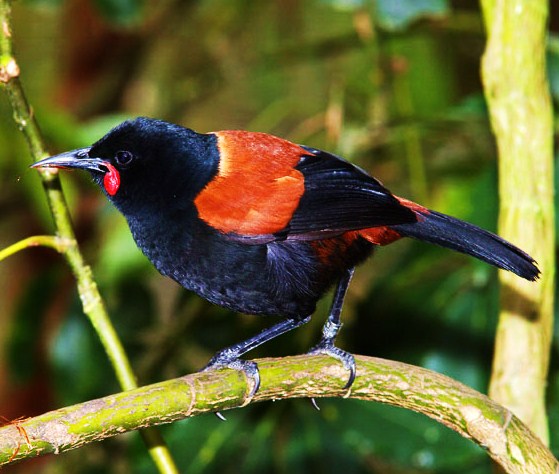Philesturnus carunculatus
 |
| Photo by Paddy Ryan (Ryan Photographic) |
Common name:
saddleback (en); tieque (pt); créadion rounoir (fr); tieke (es); sattelvogel (de)
Taxonomy:
Order Passeriformes
Family Callaeidae
Range:
The saddleback is endemic to New Zealand, and was once widespread over the North and South Islands, and some offshore islands, but by the early 1900s, was extinct on the mainland. Today it mostly occurs in offshore islands, with several introductions in progress in both the islands and the New Zealand mainland.
Size:
These birds are 25 cm long and weigh 70-80 g.
Habitat:
The saddleback inhabits the native forests of New Zealand, but also occurs in coastal scrublands.
Diet:
These birds are mostly insectivorous, but are also known to eat fruits and occasionally nectar.
Breeding:
Saddlebacks typically breed in October-January, but will nest up to 4 times per year at recently colonised sites where resources are not limiting. They nest in tree holes, rock crevices, tree-fern crowns and dense epiphytes, usually close to the ground. The female lays 2-3 eggs which she incubates alone for 18-20 days. After the eggs have hatched, the male gathers food to be distributed between the chicks and the female, and chicks will fledge 25-27 days after hatching.
Conservation:
IUCN status – NT (Near-Threatened)
This species is confined to a number of predator free islands around New Zealand. The populations is currently estimated at 7.200 individuals and is increasing due to intensive conservation management. The main threat affecting this species is the predation by introduced mammals, namely black rat Rattus rattus, brown rat Rattus norvegicus and Pacific rat Rattus exulans. The species has been introduced to several predator free islands and to native forests surrounded by a predator-proof fence on the New Zealand mainland, but the accidental introduction of rats to further islands is an ever-present threat.







